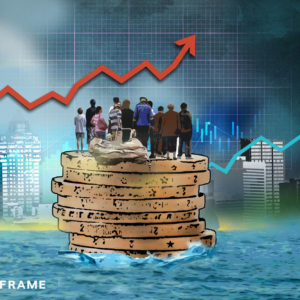Who gets the ‘dirty’ profits while going for ‘clean’?
In the first of two articles on the energy transition that must happen across the world, it’s clear that coal will be around for years to come. Less clear is who will benefit from it.
Author:
21 April 2022

Current proposals for an energy transition in South Africa are wholly inadequate. The energy transition is a marathon that will be run for at least three decades and it needs a well-considered strategy to complete successfully.
Countries that try to sprint from the start are likely to fall by the wayside. Yet the popular narrative promoted in South Africa doesn’t move beyond the cheap populism that simply asserts that Eskom and fossil fuel-based energy production are evils that need to be got rid of at the greatest possible speed.
The world must undoubtedly transition to a new energy system, but it will be a hugely complex and costly project. To make a successful transition, each country – and community – will have to address its specific challenges.
Related article:
For a country as unequal as South Africa, a primary concern will be to ensure a genuinely “just transition”. It should not impose unreasonable burdens on ordinary South Africans, particularly workers and the impoverished, through retrenchments, extra taxes, unreasonable energy price hikes or reduced public services. The transition strategy must consider the implications for public finances, therefore, and it must also consider the implications for national sovereignty and stability.
At present, groups with strong vested interests are encouraging South Africa to make a fast and radical transition without explaining how the costs incurred in doing so will be paid and by whom. Worse, they want the country to do this in a way that would reduce the income it could earn to fund the transition.
The current model for transition to green energy is through rapid privatisation. It amounts to a form of self-imposed structural adjustment that threatens to repeat the economic policy mistakes of the 1990s. These collapsed the manufacturing sector of the economy and closed many paths to a more inclusive and prosperous society.
Weaker and more dependent
Meanwhile, the wildly overhyped promised external support for a just transition in South Africa is limited. Close inspection of the “green financing” deal for the country, announced with much fanfare at the COP26 climate change conference held in Scotland in November last year, reveals unfavourable terms and little real financial support.
Populist campaigns that push for the swiftest possible transition to privatised forms of green energy production are likely to contribute to turning an already difficult transition into a brutal one. Instead of ensuring that South Africa can design, fuel and fund its transition primarily from domestic resources, it will become even more dependent on energy imports and conditional external funding.
This will reduce its ability to negotiate trade and finance deals, including for renewable energy investments, further undermining its economic sovereignty. It will weaken public finances and reduce the resources needed to address poverty and inequality in a sustainable way. And history shows that weakened sovereignty on these fronts can weaken political sovereignty as well.
Related article:
While many domestic commentators like to frame South Africa as some kind of energy pariah, this does not hold up against a global perspective. Globally, South Africa is being outplayed by more powerful nations who seek to maximise their returns from their hydrocarbon resources while they still can.
Take Australia. Back in 1981, its national intelligence agency, the Office of National Assessments, warned then-prime minister Malcolm Fraser that by the middle of the 21st century, CO₂ emissions would cause climatic change that “would require major economic and social adjustments”.
The primary concern for Australia was not climate change. It was rather the “potentially adverse implication … for the security of Australia’s export markets for coal”. The country’s response was simple and is now a matter of public record. It ramped up coal production to maximise its carbon income before the fateful day arrived. It also encouraged the exploitation of its offshore gas fields. So today Australia is not only the world’s largest coal exporter, but also the largest exporter of liquefied natural gas (LNG) – although in total gas exports (LNG and pipeline) it is only fifth in the world.
Making hay while sun still shines
Other rich countries are following similar strategies to Australia’s. Canada has a relatively low-carbon domestic electricity system, thanks to extensive hydropower and nuclear generating capacity. But despite local opposition, Canada continues to exploit its huge reserves of dramatically dirty “tar sands” despite the extreme environmental and social damage. The aim is to produce oil for export, maximising its hydrocarbon income while it still can.
Canada’s big neighbour, the United States, is even more aggressive. In the 1970s, the US produced much of its electricity from local coal. For transport fuels, however, it depended on oil imports from cheap but politically unstable, or destabilised, Middle East countries.
Like Canada, the US has huge, potentially valuable reserves of gas and oil in shale rocks that are difficult to tap. Fracking technologies, developed with support from the government, have solved the technical problems and transformed the country’s energy sector. Expanded gas supplies are replacing coal for electricity generation, enabling a significant reduction in CO₂ emissions. This has turned the US into a net exporter, with both the Trump and Biden administrations aggressively promoting LNG exports.
Related article:
As energy prices fluctuate dramatically worldwide, providing transitional solutions – dirty old coal – remains a highly profitable business. AGL Energy, which is responsible for 8% of Australia’s CO₂ emissions, rejected a bid from US private equity company Brookfield saying it was well below fair value. AGL Energy intends to continue using coal until 2045, which will help it to build a renewables business.
In South Africa, the future value of a few decades of coal-fired business was demonstrated when Anglo American sold its local coal business to Thungela Resources, a black economic empowerment company, in June last year. Thungela’s share price has since gone up over 600%, with most of that rise happening even before the Ukraine crisis.
The importance of local mining production for public finances was demonstrated by the tax windfall from higher commodity prices that helped to relieve the post-Covid fiscal shock, just as it boosted public finances before the global financial crisis of 2007.
Worsening inequity
So whether one likes it or not, profits will continue to be made from fossil fuels during the energy transition. The question now is who will capture those profits and for whose benefit will they be used? A just transition would see the transitional profits go to the more impoverished countries that bear the heaviest burdens. That’s not currently happening and, if anything, the present trajectory suggests the inequity will worsen.
As Mia Mottley, prime minister of Barbados, put it earlier in March, developing countries need “a way to finance our route to net zero”. And if the wealthy nations that “caused the problems” would not provide funding, these countries would need to find other ways to generate revenue, such as exporting fossil fuels. “There has to be equity,” she told a Financial Times climate conference.
Historically, wealthy countries have been reluctant to really pay their share. In 2007, the then Ecuadorian president Rafael Correa proposed that wealthy countries pay Ecuador not to drill for oil in an Amazon rainforest reserve. In other words, he wanted them to compensate Ecuadoreans for the national revenue they would lose by keeping oil in the ground. Of the $3.6 billion proposed, only $13 million was forthcoming and the oil drilling in the Amazon went ahead.
Related article:
The question that motivated Correa was simple: why should poor countries sacrifice much-needed revenues from exploiting natural resources when rich countries that can better afford this sacrifice are often not doing so? This same question can be applied in South Africa and beyond to other Southern African Development Community countries that have strong incentives to “monetise” their hydrocarbon reserves to help fund the building of their domestic power systems and economies.
The stated aim of virtually all campaigns in South Africa at present is to achieve a “just transition”. But analysis of South Africa’s options, supported by evidence from the rest of the world, suggests that their effect is more likely to impose an unnecessarily brutal transition on the majority of South Africans and a loss of energy and political sovereignty.
Séan Muller does not receive any funding, or have any other conflicts of interest, related to the subject of this article.
Mike Muller’s pension is invested in, among others, renewable and conventional energy and construction companies.




